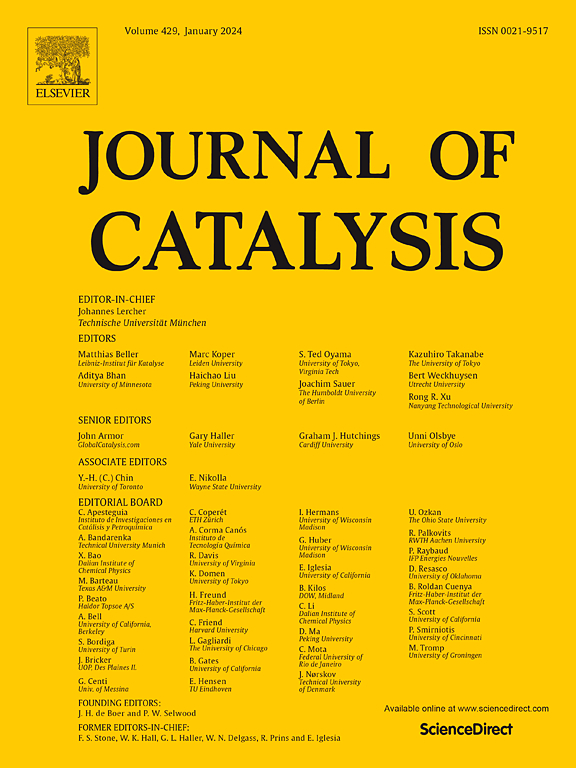Design of bifunctional oxygen evolution/reduction electrocatalysts on g-C3N3 monolayer by a defect physics method
IF 6.5
1区 化学
Q2 CHEMISTRY, PHYSICAL
引用次数: 0
Abstract
Designing efficient and stable bifunctional oxygen evolution/reduction reaction (OER/ORR) electrocatalysts is important to developing renewable energy technologies. However, integrating OER/ORR activity in a single electrocatalyst remains challenging due to the difficulty in balancing the adsorption strengths of reaction intermediates. Herein, density functional theory (DFT) calculations were conducted to investigate 4d-transition metal (TM) doped graphitic carbon nitride (4d-TM@C3N3) systems as potential bifunctional OER/ORR electrocatalysts by considering the charge states through a defect physics method. Our results identified 30 stable 4d-TMN@C3N3 systems, including TM doped at nitrogen sites (4d-TMN@C3N3) and those occupying interstitial sites (4d-TMint@C3N3). Machine learning analysis showed that the the bond lengths between TM and O (dTM-O) and OH (dTM-OH), and the charge transfer of TM atoms (Qe) are the three primary descriptors characterizing the adsorption behavior. Among these, Pdint×@C3N3 (Pd interstitial site, neutral charge state), Pdint•@C3N3 (Pd interstitial site, +1 charge state), and Rhint•@C3N3 (Rh interstitial site, +1 charge state) exhibit outstanding OER/ORR catalytic activity with ηOER/ηORR of 0.56/0.37 V, 0.66/0.37 V, and 0.59/0.44 V, respectively, which are comparable to benchmark electrocatalysts such as RuO2 for OER (0.69 V) and Pt for ORR (0.61 V). The enhanced performance arises from charged defects adjustment that optimizes the bifunctional OER/ORR activity, offering potential electrocatalysts for energy conversion applications.


缺陷物理法设计g-C3N3单层双功能析氧/还原电催化剂
设计高效、稳定的双功能析氧/还原反应(OER/ORR)电催化剂对发展可再生能源技术具有重要意义。然而,由于难以平衡反应中间体的吸附强度,将OER/ORR活性整合到单一电催化剂中仍然具有挑战性。本文通过缺陷物理方法考虑电荷态,利用密度泛函理论(DFT)对掺杂石墨氮化碳(4d-TM@C3N3)的4d过渡金属体系作为潜在的双功能OER/ORR电催化剂进行了研究。我们的研究结果确定了30个稳定的4d-TMN@C3N3体系,包括在氮位点掺杂的TM (4d-TMN@C3N3)和占据间隙位点的TM (4d-TMint@C3N3)。机器学习分析表明,TM与O之间的键长(dTM-O)和OH (dTM-OH)以及TM原子的电荷转移(Qe)是表征TM吸附行为的三个主要描述符。其中,Pdint×@C3N3 (Pd间隙位,中性电荷态)、Pdint∙@C3N3 (Pd间隙位,+1电荷态)和Rhint∙@C3N3 (Rh间隙位,+1电荷态)表现出出色的OER/ORR催化活性,ηOER/ηORR分别为0.56/0.37 V、0.66/0.37 V和0.59/0.44 V,与RuO2对OER(0.69 V)和Pt对ORR(0.61 V)等基准电催化剂相当。增强的性能源于带电缺陷调整,优化了双功能OER/ORR活性,为能量转换应用提供了潜在的电催化剂。
本文章由计算机程序翻译,如有差异,请以英文原文为准。
求助全文
约1分钟内获得全文
求助全文
来源期刊

Journal of Catalysis
工程技术-工程:化工
CiteScore
12.30
自引率
5.50%
发文量
447
审稿时长
31 days
期刊介绍:
The Journal of Catalysis publishes scholarly articles on both heterogeneous and homogeneous catalysis, covering a wide range of chemical transformations. These include various types of catalysis, such as those mediated by photons, plasmons, and electrons. The focus of the studies is to understand the relationship between catalytic function and the underlying chemical properties of surfaces and metal complexes.
The articles in the journal offer innovative concepts and explore the synthesis and kinetics of inorganic solids and homogeneous complexes. Furthermore, they discuss spectroscopic techniques for characterizing catalysts, investigate the interaction of probes and reacting species with catalysts, and employ theoretical methods.
The research presented in the journal should have direct relevance to the field of catalytic processes, addressing either fundamental aspects or applications of catalysis.
 求助内容:
求助内容: 应助结果提醒方式:
应助结果提醒方式:


